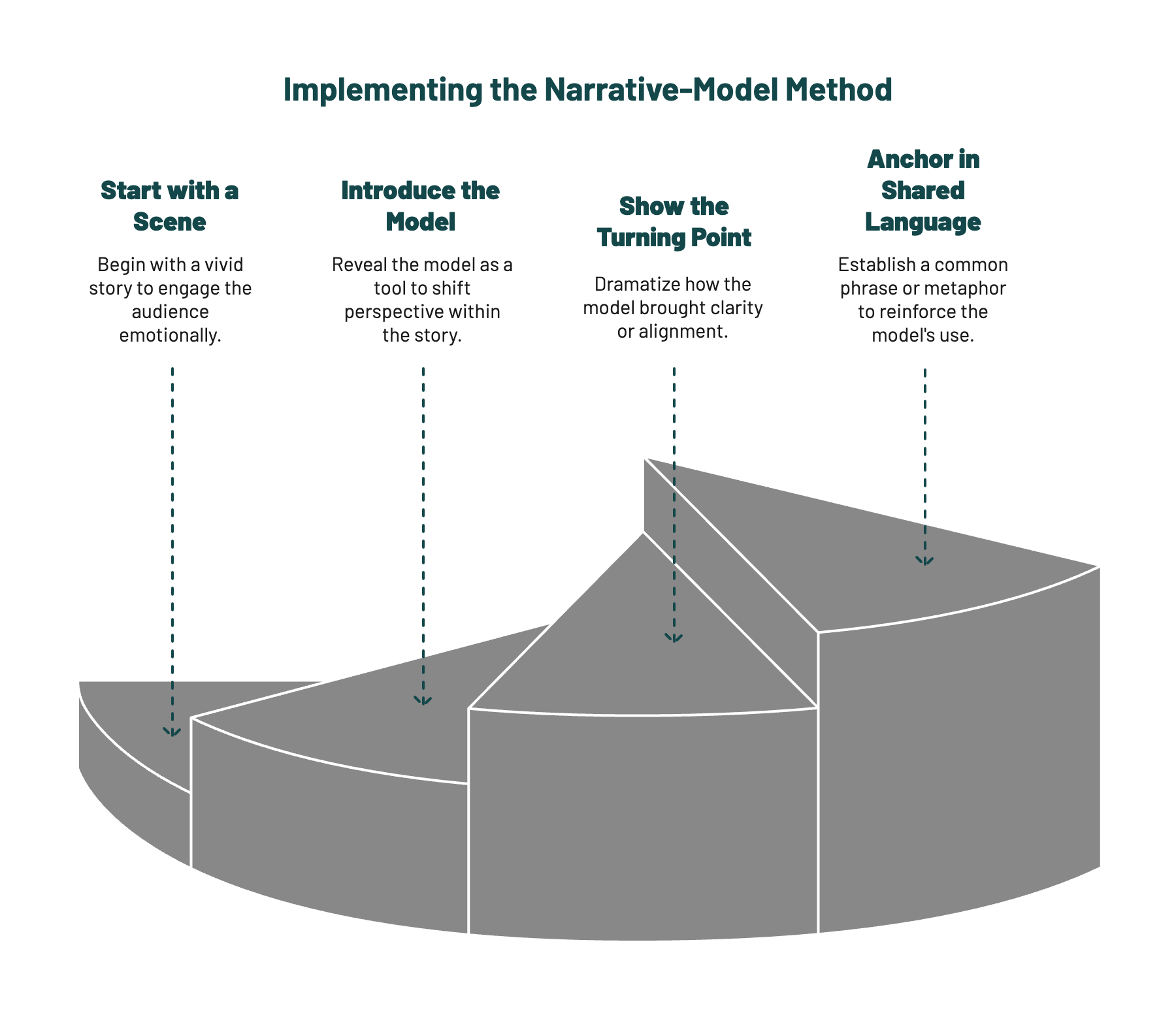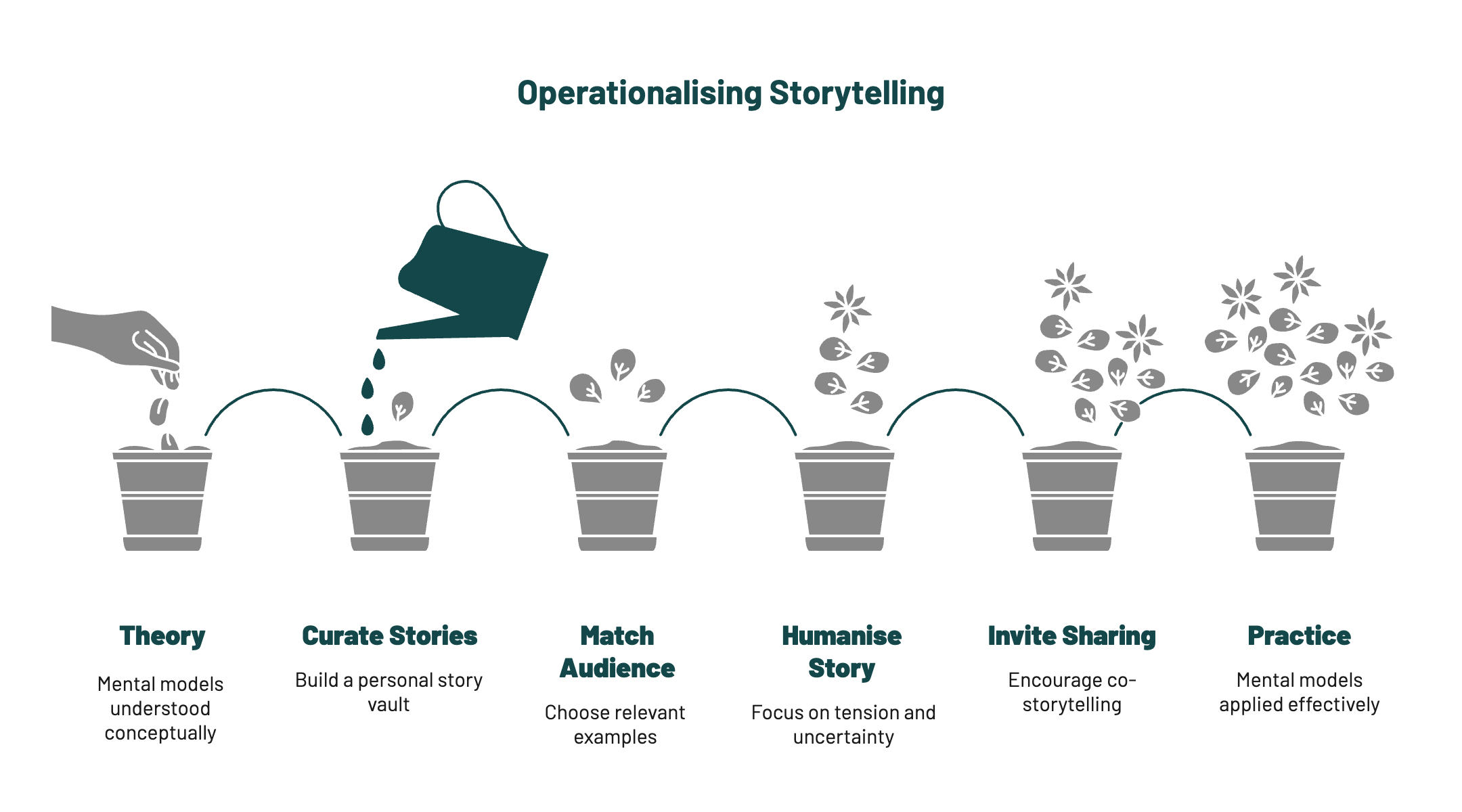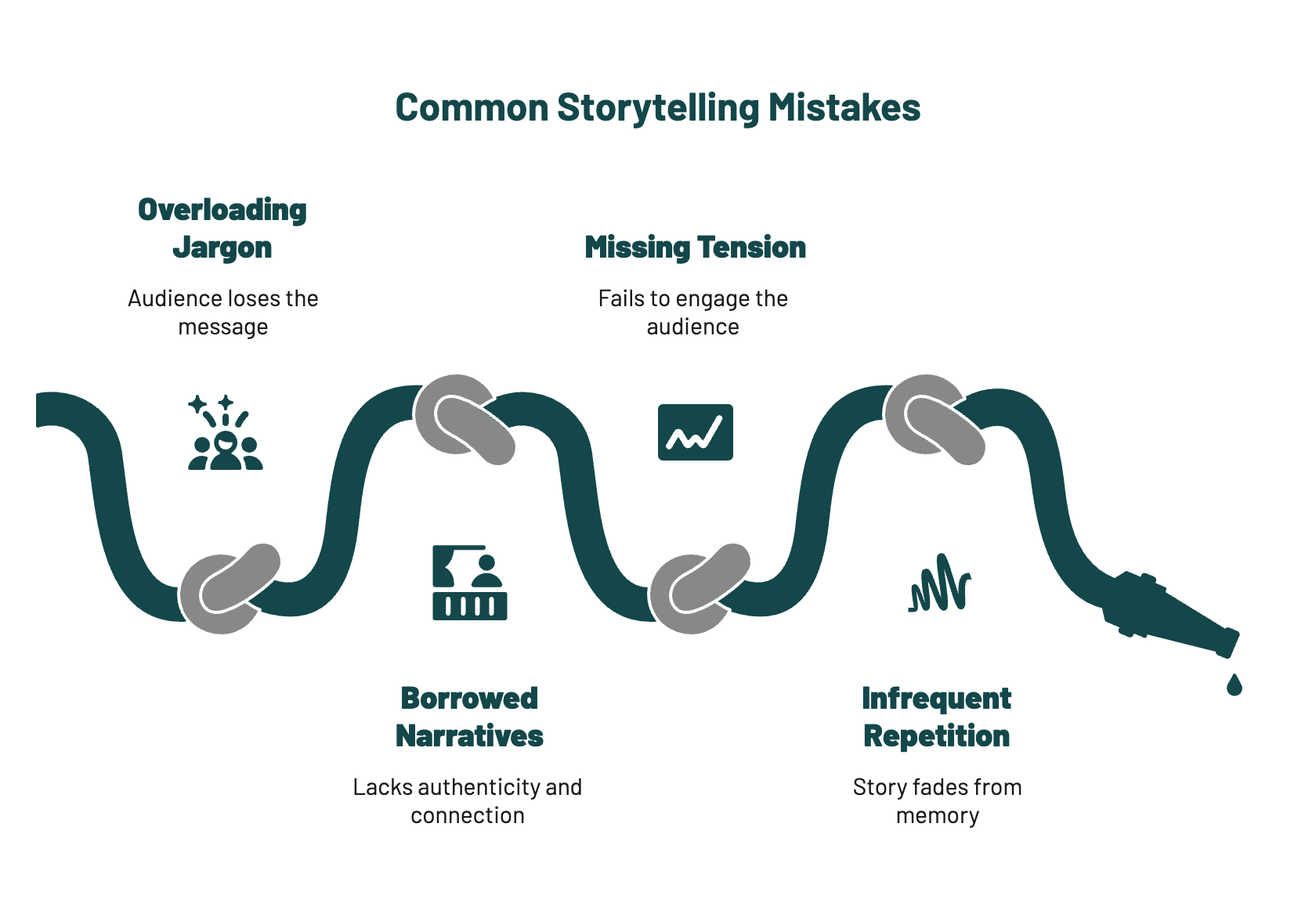Mental Model
August 18, 2025
5
Min
Teaching Mental Models Through Storytelling
Mental Model
|
We have seen executives try to introduce mental models by handing out slides, distributing PDFs, or quoting a favourite business book. Often, the result is polite nodding followed by little actual uptake. Why? Because models remain abstract until people see themselves in them. That is where storytelling changes the game.
Mental models are shorthand ways of making sense of complexity. The Eisenhower Matrix, Inversion Thinking, or the Pareto Principle work precisely because they cut through noise. But unless those frameworks are anchored in lived experience, they can float above reality.
Research from cognitive psychology confirms this: humans recall stories up to 22 times more effectively than facts or numbers alone (Jerome Bruner). Stories don’t just illustrate a model; they make it memorable, shareable, and repeatable. For senior leaders charged with cascading strategic thinking through organisations, that matters enormously.

We suggest a deliberate approach we call The Narrative-Model Method. It has four parts:
Instead of opening with the model, open with a vivid story. Set a moment in time: a product launch gone wrong, a merger conversation that hit an impasse, a team paralysed by options. By grounding the audience in something real, you invite emotional connection.
Reflection prompt: Think of one decision in your career where stakes were high and clarity scarce. How would you narrate that scene?
Once the audience is inside the story, reveal the model as the lens that shifts perspective. For example: “At that moment, we used Inversion Thinking - instead of asking how to succeed, we asked how we might fail.” The model then becomes not abstract theory but a tool proven under fire.
Micro-action: Next time you teach a model, resist the slide. Instead, tie its introduction directly to a turning point in your story.
Stories hinge on moments where something changes. Here, show how the model delivered clarity or alignment. Did the team’s decision criteria sharpen? Did resources reallocate faster? By dramatizing the pivot, the power of the model is felt, not just understood.
Reflection prompt: Which model in your toolkit has most often created a breakthrough moment? What story do you tell to show that?
Finally, give the audience a phrase, diagram, or metaphor to repeat. This is how stories harden into culture. “Remember the jam-jar test” or “Don’t forget the 70/20/10 rule” becomes a shorthand everyone can use in the next decision.
Micro-action: Craft one sticky line that captures both the model and the story. Test if your team uses it unprompted.

Here’s how leaders can operationalise storytelling as a teaching device for mental models:
Pro Tip: Do not sanitise the story into a flawless case study. Vulnerability in the telling is what makes the model credible.


Prompt 1: If your team had to retell one of your stories tomorrow, which would they remember word-for-word?
Prompt 2: Choose one model you value. Draft the first 3 lines of a story you could use to teach it.
When leaders teach models through story, three benefits emerge:
In our coaching rooms, we’ve watched leaders transform mental models from abstract frameworks into living practices by embedding them in narrative. That shift doesn’t just improve comprehension; it creates strategic coherence across levels.
Pick one mental model you believe your team underuses. Pair it with one story from your career that illustrates its power. Tell that story at your next meeting. Then, listen for the moment the phrase or model begins echoing back to you. That is the sign it has landed.
Team SHIFT
What if the difference between a leader who inspires strategic clarity and one who leaves their team in a fog is not the model they use, but the way they teach it?
We have seen executives try to introduce mental models by handing out slides, distributing PDFs, or quoting a favourite business book. Often, the result is polite nodding followed by little actual uptake. Why? Because models remain abstract until people see themselves in them. That is where storytelling changes the game.
Mental models are shorthand ways of making sense of complexity. The Eisenhower Matrix, Inversion Thinking, or the Pareto Principle work precisely because they cut through noise. But unless those frameworks are anchored in lived experience, they can float above reality.
Research from cognitive psychology confirms this: humans recall stories up to 22 times more effectively than facts or numbers alone (Jerome Bruner). Stories don’t just illustrate a model; they make it memorable, shareable, and repeatable. For senior leaders charged with cascading strategic thinking through organisations, that matters enormously.

We suggest a deliberate approach we call The Narrative-Model Method. It has four parts:
Instead of opening with the model, open with a vivid story. Set a moment in time: a product launch gone wrong, a merger conversation that hit an impasse, a team paralysed by options. By grounding the audience in something real, you invite emotional connection.
Reflection prompt: Think of one decision in your career where stakes were high and clarity scarce. How would you narrate that scene?
Once the audience is inside the story, reveal the model as the lens that shifts perspective. For example: “At that moment, we used Inversion Thinking - instead of asking how to succeed, we asked how we might fail.” The model then becomes not abstract theory but a tool proven under fire.
Micro-action: Next time you teach a model, resist the slide. Instead, tie its introduction directly to a turning point in your story.
Stories hinge on moments where something changes. Here, show how the model delivered clarity or alignment. Did the team’s decision criteria sharpen? Did resources reallocate faster? By dramatizing the pivot, the power of the model is felt, not just understood.
Reflection prompt: Which model in your toolkit has most often created a breakthrough moment? What story do you tell to show that?
Finally, give the audience a phrase, diagram, or metaphor to repeat. This is how stories harden into culture. “Remember the jam-jar test” or “Don’t forget the 70/20/10 rule” becomes a shorthand everyone can use in the next decision.
Micro-action: Craft one sticky line that captures both the model and the story. Test if your team uses it unprompted.

Here’s how leaders can operationalise storytelling as a teaching device for mental models:
Pro Tip: Do not sanitise the story into a flawless case study. Vulnerability in the telling is what makes the model credible.


Prompt 1: If your team had to retell one of your stories tomorrow, which would they remember word-for-word?
Prompt 2: Choose one model you value. Draft the first 3 lines of a story you could use to teach it.
When leaders teach models through story, three benefits emerge:
In our coaching rooms, we’ve watched leaders transform mental models from abstract frameworks into living practices by embedding them in narrative. That shift doesn’t just improve comprehension; it creates strategic coherence across levels.
Pick one mental model you believe your team underuses. Pair it with one story from your career that illustrates its power. Tell that story at your next meeting. Then, listen for the moment the phrase or model begins echoing back to you. That is the sign it has landed.
Team SHIFT
What if the difference between a leader who inspires strategic clarity and one who leaves their team in a fog is not the model they use, but the way they teach it?
We have seen executives try to introduce mental models by handing out slides, distributing PDFs, or quoting a favourite business book. Often, the result is polite nodding followed by little actual uptake. Why? Because models remain abstract until people see themselves in them. That is where storytelling changes the game.
Mental models are shorthand ways of making sense of complexity. The Eisenhower Matrix, Inversion Thinking, or the Pareto Principle work precisely because they cut through noise. But unless those frameworks are anchored in lived experience, they can float above reality.
Research from cognitive psychology confirms this: humans recall stories up to 22 times more effectively than facts or numbers alone (Jerome Bruner). Stories don’t just illustrate a model; they make it memorable, shareable, and repeatable. For senior leaders charged with cascading strategic thinking through organisations, that matters enormously.

We suggest a deliberate approach we call The Narrative-Model Method. It has four parts:
Instead of opening with the model, open with a vivid story. Set a moment in time: a product launch gone wrong, a merger conversation that hit an impasse, a team paralysed by options. By grounding the audience in something real, you invite emotional connection.
Reflection prompt: Think of one decision in your career where stakes were high and clarity scarce. How would you narrate that scene?
Once the audience is inside the story, reveal the model as the lens that shifts perspective. For example: “At that moment, we used Inversion Thinking - instead of asking how to succeed, we asked how we might fail.” The model then becomes not abstract theory but a tool proven under fire.
Micro-action: Next time you teach a model, resist the slide. Instead, tie its introduction directly to a turning point in your story.
Stories hinge on moments where something changes. Here, show how the model delivered clarity or alignment. Did the team’s decision criteria sharpen? Did resources reallocate faster? By dramatizing the pivot, the power of the model is felt, not just understood.
Reflection prompt: Which model in your toolkit has most often created a breakthrough moment? What story do you tell to show that?
Finally, give the audience a phrase, diagram, or metaphor to repeat. This is how stories harden into culture. “Remember the jam-jar test” or “Don’t forget the 70/20/10 rule” becomes a shorthand everyone can use in the next decision.
Micro-action: Craft one sticky line that captures both the model and the story. Test if your team uses it unprompted.

Here’s how leaders can operationalise storytelling as a teaching device for mental models:
Pro Tip: Do not sanitise the story into a flawless case study. Vulnerability in the telling is what makes the model credible.


Prompt 1: If your team had to retell one of your stories tomorrow, which would they remember word-for-word?
Prompt 2: Choose one model you value. Draft the first 3 lines of a story you could use to teach it.
When leaders teach models through story, three benefits emerge:
In our coaching rooms, we’ve watched leaders transform mental models from abstract frameworks into living practices by embedding them in narrative. That shift doesn’t just improve comprehension; it creates strategic coherence across levels.
Pick one mental model you believe your team underuses. Pair it with one story from your career that illustrates its power. Tell that story at your next meeting. Then, listen for the moment the phrase or model begins echoing back to you. That is the sign it has landed.
Team SHIFT
